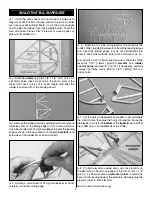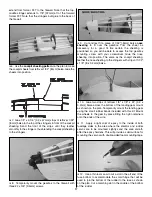
INTRODUCTION . . . . . . . . . . . . . . . . . . . . . . . . . . . . . . 2
SAFETY PRECAUTIONS . . . . . . . . . . . . . . . . . . . . . . . 3
DECISIONS YOU MUST MAKE . . . . . . . . . . . . . . . . . . . 3
Radio equipment . . . . . . . . . . . . . . . . . . . . . . . . . . . 3
Speed control . . . . . . . . . . . . . . . . . . . . . . . . . . . . . 3
Motor system . . . . . . . . . . . . . . . . . . . . . . . . . . . . . . 4
Battery and charger . . . . . . . . . . . . . . . . . . . . . . . . . 4
Covering . . . . . . . . . . . . . . . . . . . . . . . . . . . . . . . . . 4
Building board . . . . . . . . . . . . . . . . . . . . . . . . . . . . . 4
ADDITIONAL ITEMS REQUIRED . . . . . . . . . . . . . . . . . 4
Building supplies . . . . . . . . . . . . . . . . . . . . . . . . . . . 4
Optional supplies and tools . . . . . . . . . . . . . . . . . . . 4
IMPORTANT BUILDING NOTES . . . . . . . . . . . . . . . . . . 5
Metric conversions . . . . . . . . . . . . . . . . . . . . . . . . . . 5
LASER-CUT PATTERNS . . . . . . . . . . . . . . . . . . . . . . . . 6
BUILD THE TAIL SURFACES. . . . . . . . . . . . . . . . . . . . . 7
BUILD THE WING . . . . . . . . . . . . . . . . . . . . . . . . . . . . . 8
Build the center section . . . . . . . . . . . . . . . . . . . . . . 8
Build the outer panels . . . . . . . . . . . . . . . . . . . . . . . 9
Join the outer panels to the center section . . . . . . . 10
Build the ailerons . . . . . . . . . . . . . . . . . . . . . . . . . . 11
BUILD THE FUSELAGE. . . . . . . . . . . . . . . . . . . . . . . . 13
Frame the sides . . . . . . . . . . . . . . . . . . . . . . . . . . . 13
Mount the stab and fin . . . . . . . . . . . . . . . . . . . . . . 15
Finish the fuselage. . . . . . . . . . . . . . . . . . . . . . . . . 16
COVER THE MODEL . . . . . . . . . . . . . . . . . . . . . . . . . . 18
Final preparations . . . . . . . . . . . . . . . . . . . . . . . . . 18
Suggested covering sequence . . . . . . . . . . . . . . . . 18
FINAL ASSEMBLY . . . . . . . . . . . . . . . . . . . . . . . . . . . 18
Hook yp the controls . . . . . . . . . . . . . . . . . . . . . . . 18
Finish the cockpit . . . . . . . . . . . . . . . . . . . . . . . . . . 19
PREPARE THE MODEL FOR FLYING . . . . . . . . . . . . . 20
Balance the model . . . . . . . . . . . . . . . . . . . . . . . . . 20
Set up the radio . . . . . . . . . . . . . . . . . . . . . . . . . . . 21
Set the control throws . . . . . . . . . . . . . . . . . . . . . . 21
PREFLIGHT. . . . . . . . . . . . . . . . . . . . . . . . . . . . . . . . . 21
Charge the transmitter batteries . . . . . . . . . . . . . . . 21
Identify your model. . . . . . . . . . . . . . . . . . . . . . . . . 22
Ground inspection . . . . . . . . . . . . . . . . . . . . . . . . . 22
Range check . . . . . . . . . . . . . . . . . . . . . . . . . . . . . 22
PERFORMANCE TIPS . . . . . . . . . . . . . . . . . . . . . . . . . 22
Cycle the batteries . . . . . . . . . . . . . . . . . . . . . . . . . 22
Examine the propeller . . . . . . . . . . . . . . . . . . . . . . 22
Mount the wing . . . . . . . . . . . . . . . . . . . . . . . . . . . 22
Motor care . . . . . . . . . . . . . . . . . . . . . . . . . . . . . . . 22
Oil the wheels . . . . . . . . . . . . . . . . . . . . . . . . . . . . 22
MOTOR SAFETY PRECAUTIONS . . . . . . . . . . . . . . . . 22
AMA SAFETY CODE . . . . . . . . . . . . . . . . . . . . . . . . . . 23
FIND A SAFE PLACE TO FLY . . . . . . . . . . . . . . . . . . . 23
FLYING . . . . . . . . . . . . . . . . . . . . . . . . . . . . . . . . . . . . 23
Takeoff. . . . . . . . . . . . . . . . . . . . . . . . . . . . . . . . . . 23
Flight . . . . . . . . . . . . . . . . . . . . . . . . . . . .
back cover
Landing . . . . . . . . . . . . . . . . . . . . . . . . . .
back cover
ROG Takeoff . . . . . . . . . . . . . . . . . . . . . .
back cover
Congratulations and thank you for purchasing the
Great
Planes Li’l Poke
. The
Li’l Poke is one in a series of Park Flyers
from Great Planes designed to be flown in small areas. Park
Flyers are a relatively new class of small, lightweight, slow-
flying models. Because Park Flyers can fly in small areas, a
nearby park, schoolyard or vacant lot becomes an impromptu
flying site. Additionally, Park Flyers are perfect for those
evenings at the field when everybody else is packing up their
gear, the wind has died, and there is still enough light to fly a
small, slow model that can be kept close-in.
The Li’l Poke may be built either with or without ailerons. It
flies well on rudder only, but flying with ailerons increases its
maneuverability.
The Li’l Poke is a slow flying model that is simple to build. It
is ideal for modelers with moderate flight experience, or
even experienced modelers who simply wish to try out a
small, lightweight electric model. However, the Li’l Poke is
not intended for beginners. If you have little flight experience
or have not flown a model like this before, find an
experienced modeler to help you with your first flights.
Information about R/C clubs and instructors is provided later
in this manual.
IMPORTANT!!!
Although the Li’l Poke is a small, lightweight
model that may be flown in parks, schoolyards, empty lots
and fields, it is operated by the same radio controlled
equipment used to fly larger, conventional R/C airplanes,
and is therefore capable of generating radio interference that
could cause one of these larger models to crash. Because of
this, you must be aware of your proximity to R/C club sites if
flying somewhere on your own. If there is an R/C site within
five miles of where you are flying, and if you are operating
your model on the same frequency and at the same time as
somebody else, there is a
strong
possibility that one or both
models will crash due to radio interference. Though the
potential for the Li’l Poke to cause damage may be small,
there is
great
potential for a larger model to cause property
damage and/or severe personal injury if radio interference
causes loss of control. We
strongly
urge you to fly at a R/C
club site where frequency control is in effect, so you can be
assured you will be the only one flying on your channel. If you
insist on flying on your own and do not know where the R/C
club sites are, contact the local hobby shop or the AMA to
find out. When completed, you will have invested
considerable time and expense in your Li’l Poke. It would be
a shame to crash it simply due to unnecessary radio
interference. The time and expense that goes into a larger
model is even greater (as is the potential danger), so
make
certain
you are not flying within five miles of a local R/C club
where radio interference from your transmitter could cause
a crash.
INTRODUCTION
TABLE OF CONTENTS
2



































